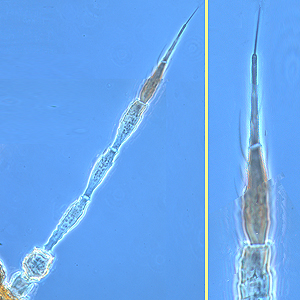Figures
Fig. 1: Antenna (inset: V. - VII. antennal segment)
Fig. 2: Head dorsal with ocellar triangle
Fig. 3: Pro-, meso- and metanotum
Fig. 4: Pronotum
Fig. 5: Meso- and metanotum
Fig. 6: Fore- and hindwing (inset: setae of forewein)
Fig. 7: Tergites VII and VIII
Fig. 8: Tergites VIII-X
ITS-RFLP gel patterns (1&8 ladder, 2 PCR-product, 3 RSAI, 4 HaeIII, 5 MspI, 6
HinfI, 7 AluI)
Fig. 9: Primer pair O1/18J
Fig. 10: Primer pair P1/28Z
Fig. 11: Primer pair TODA1/TODA2
Taxonomic Information
Species:
Parthenothrips dracaenae (Heeger, 1854)
Synonyms:
Parthenothrips concolor Uzel, 1895
Parthenothrips dracaenae Uzel, 1895
Thrips dracaenae Heeger, 1854
Heliothrips dracaenae Heeger, 1854
Common name:
Palm thrips
Present taxonomic position:
Family: Thripidae Stephens, 1829
Subfamily: Panchaetothripinae Bagnall, 1912
Genus: Parthenothrips Uzel, 1895
Species Recognition
General information about the genus Parthenothrips:There is only one species in this genus and it can be described as handsome in appearance. The body is golden brown with heavy sculpture on the head, legs, thorax and wings. The forewings are broad with the reticulate surface pale with one dark band in the basal half and one small shaded area distally.
Typical character states of Parthenothrips dracaenae:
Body color
Mainly brown
Antennae
Number of antennal segments: 7
Segments III & IV sensoria: emergent and simple
Terminal antennal segments: very long, needle like
Head:
Head shape between compound eyes: not prolonged
Sculptured reticles on head and pronotum: with no internal markings
Surface of head, pronotum and fore legs: with strong reticulate sculpture, but sometimes irregular
Head posteriorly: constricted
Prothorax
Number of pairs of elongate pronotal setae: 0-3
Number of pairs of elongate posteroangular pronotal setae: 1
Pronotum shape: rectangular
Sculptur of pronotum: without transverse striate sculpture
Mesothorax
Mesothoracic endofurca: without median spinula
Metathorax
Metanotum: without campaniform sensilla
Metanotum major sclerite: with two major sclerites, metascutum and metascutellum
Metanotum median area: with at least some equiangular reticulation
Metanotum sculpture: without dominant sculptured triangle medially
Metathoracic endofurca: elongate and Y-shaped
Wings
Wings: present and more than half as long as abdomen
First vein of forewing: close to or fused to costal vein
Forewing anterior margin: with setae but no cilia
Forewing color: alternating bands of dark and light
Forewing costal setae at middle of wing: shorter than median width of wing
Forewing first vein setal row: incomplete, with setae not closely and uniformly spaced
Forewing posterior margin cilia: undulated near apex
Forewing second vein setal row: complete, with setae closely and uniformly spaced
Forewing surface: strongly reticulate
Forewings: with veins, setae and microtrichia
Legs
Mid and hind tarsi: with one segment
Abdomen:
Abdominal segment X: never tubular, longitudinally incomplete ventrally in both sexes
Abdominal tergites: without curved wing-retaining setae
Abdominal tergites IV & V median setal pair: much shorter than distance between their bases
Setae on abdominal tergite X: slender
Tergite VIII posteromarginal comb of microtrichia: absent
Tergites III to VI sculpture on lateral thirds: comprising mainly oblique reticulations
Biology
Life history:
This species if found as a pest in greenhouses on ornamentals such as orchids. When found this thrips is slow moving sometimes requiring prodding with a fine paint brush to stimulate flight. As with other thrips species the life cycle from egg to adult is dependent on temperature. The full cycle can take about 7 days in a greenhouse and 15 days to over a month in outdoor populations and adults may live for more than one month producing several generations in one year depending on seasonal weather (Lewis,
1973).
Host plants:
Ficus elastica, Chamaeodorae,
palms, ornamentals in greenhouses, also on fern (Adiantum
spp.).
Vector capacity:
None identified
Current known distribution:
Africa, Asia, Australia, New Zealand,
Central and South America, Europe, North America
Additional notes:
Worldwide distributed in greenhouses
on ornamental plants and found in outdoor populations in the tropics.
Bibliography
Bailey, SF (1957): The
thrips of California Part I: Suborder Terebrantia. Bulletin of the
California Insect Survey 4, no. 5: 143-220.
Lewis, T (1973): Thrips their biology, ecology and economic
importance. Academic Press Inc., London Ltd. 349 pp.
Moritz G, Morris DC, Mound LA (2001): ThripsID -
Pest thrips of the world. ACIAR
and CSIRO Publishing Collingwood, Victoria, Australia, CDROM ISBN
1 86320 296 X.
Moritz G, Mound LA, Morris DC, Goldarazena A (2004): Pest
thrips of the world - an identification and information system using molecular
and microscopial methods. CBIT, University of Queensland,CDROM ISBN 1-86499-781-8.
Mound, LA & Kibby, G (1998): Thysanoptera: An identification
guide, (2nd edition). CAB International, Wallingford and New
York, 70pp.
Mound, LA & Marullo, R (1996): The
thrips of Central and South America: An Introduction (Insecta: Thysanoptera).
Associated Publishers, Gainesville.
Palmer, JM, Mound, LA & Du Heaume, GJ (1989): 2.
Thysanoptera, pp. 73. In Betts, CR [ed.],
CIE Guides to Insects of Important to Man. CAB International, Wallingford.
Sakimura, K (1953): Parthenothrips dracaenae,
a Non-Vector of the Spotted Wilt Virus. - Journal of Economic Entomology
46 (2): 287-287.
Stannard, LJ (1968): The thrips, or Thysanoptera, of
Illinois. Illinois Natural History Survey Bulletin 29: 215-552.
Staub,
PF (1979): Post-embryonic development of the nervous-system of Parthenothrips
dracaenae Heeger (Thysanoptera, Terebrantia). - Revue Suisse De
Zoologie 86 (2): 367-394.
Wilson, TH (1975): A monograph of the subfamily Panchaetothripinae
(Thysanoptera: Thripidae). Memoirs of the American Entomological Institute
23: 1-354.
Links:
Mound, LA (2005): Thysanoptera (Thrips) of the World
- A Checklist. http://www.ento.csiro.au/thysanoptera/worldthrips.html












